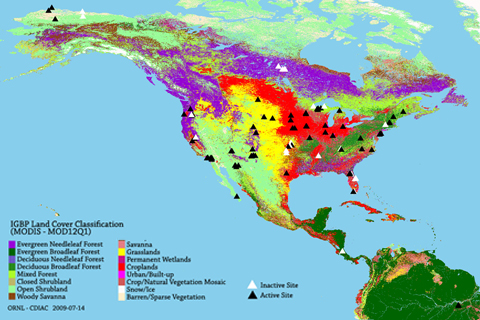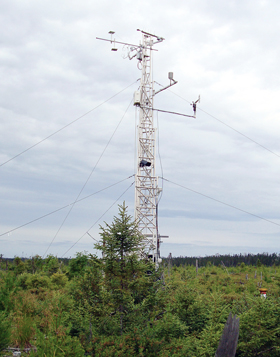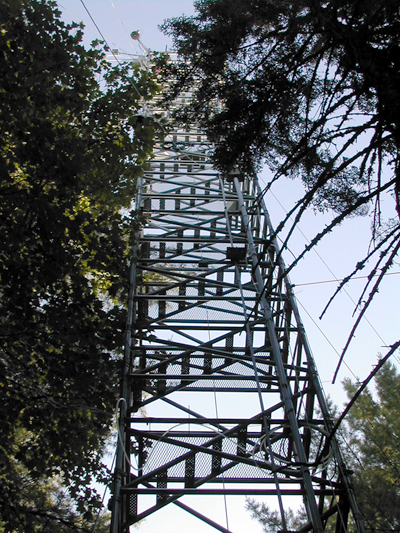Fall 2012
OF THE PROPOSAL from NASA's Earth Science program recently won by Earth Systems Research Center scientists Scott Ollinger, Jingfeng Xiao, and Heidi Asbjornsen, it could be said that their recipe for success was to just add water.
The study, titled "Exploring relationships among water use efficiency, canopy nitrogen and carbon cycling across North American ecosystems to improve land surface models," is a direct follow-on to groundbreaking remote sensing work Ollinger led several years ago that investigated the relationship between leaf nitrogen content, carbon sequestration, and albedo, or surface reflectivity.
The earlier project found that forests with high levels of leaf nitrogen may have a two-fold effect on climate by simultaneously reflecting more solar radiation and absorbing more carbon dioxide than their low-nitrogen counterparts. These findings had implications for how forests regulate climate but the researchers weren't able to nail down the overall effects without knowing the water piece of the puzzle.
 | |
| Network of AmeriFlux towers. Courtesy Oak Ridge National Laboratory. |
Notes Ollinger, professor of ecosystem ecology/remote sensing in EOS and the department of natural resources and the environment, "The evaporation of water from plants is a critical thing to understand, so we wanted to look more carefully at how forests use water and how that's affected by the nitrogen status of trees. This has implications for climate that we couldn't consider before, and it also influences the amount of water that ends up in rivers and streams."
The climate part of the equation has to do mostly with the formation of clouds from the massive amounts of water vapor sent skyward by plants. Indeed, because a lot of clouds over continents are born of water released by plants, if there were fewer plants in the world there would be less cloud cover.
 |
|
| View of a cloud-covered Earth as seen from the Gemini 3 spacecraft in March 1965. Courtesy NASA Johnson Space Center. |
"When you look at the planet from space, it's bathed in clouds and that affects Earth's albedo or its capacity to either reflect or absorb the sun's heat. And, of course, cloud cover determines how much rainfall there is. So, the planet's surface changes because of clouds, making it critical to understand how plants use water" says Ollinger, principal investigator for the three-year, $775,000 NASA project.
The in-house ability to examine water use by plants was made possible with the arrival of associate professor Heidi Asbjornsen, who came to UNH from Iowa State University. Asbjornsen is an ecosystem ecologist who, among other subdisciplines, specializes in ecohydrology—an interdisciplinary field studying the interactions between water and ecosystems (see profile of Asbjornsen' work "Linking Water with the Landscape" in this issue of Spheres).
As in the earlier study, Ollinger's thrust in the current NASA project will be using remotely sensed canopy leaf measurements of nitrogen and albedo derived from a novel combination of NASA satellite- and aircraft-based instruments. By teaming up with Asbjornsen, the group will be able to compare nitrogen levels with plant water use and examine the efficiency with which plants use water.
The final lynchpin of the study will be supported by ESRC research assistant professor Jingfeng Xiao whose work uses data from the large network of micrometeorological towers strategically located throughout North America. The Ameriflux network of "eddy covariance flux" towers measure the turbulence or "eddies" of air above treetops thus allowing scientists to monitor the exchange of carbon dioxide and water between the biosphere and the atmosphere. Xiao has been a leader in scaling data from individual towers to encompass the entire North American continent. Drawing upon his expertise helped cement the new project into an innovative, focused investigation.
Says Xiao, "The eddy covariance technique is revolutionizing both ecosystem and global ecology. The continuous observations from these towers will allow us to look at carbon and water dynamics at the ecosystem level, and the translation of fluxes from towers to North America will help us better understand the linkages among carbon, nitrogen, and water cycles at the continent scale."
From breakthrough to follow-through
Ollinger's previous work involving nitrogen, photosynthesis, and the albedo of forests was a breakthrough in that it uncovered the relationship between these variables for the first time.
"What we'd like to do in this present study is figure out how the amount of water that plants use changes as we go from sites with low nitrogen and low albedo to high nitrogen and high albedo," he says. "This will provide very basic information about how plants use water, how they adapt to drought and how the atmosphere ends up being influenced by forests."
The study will use twelve Ameriflux sites as the basis for intensive measurements, including onsite tree analysis by Asbjornsen, with Xiao using additional data from roughly 100 towers from a network of 154 across North America.
At the heart of the project is the process of evapotranspiration—the sum total of water returned to the atmosphere via evaporation from surfaces, including soils, and that transpired or "breathed" through plant leaves. Flux tower data will show how much water is going in and out of a forest (without distinguishing between evaporation and transpiration) while Asbjornsen's measurements using tree cores and isotope analysis will bring the study right down to the individual species level.
Says Asbjornsen, "For this project, we're looking at what's known as water use efficiency, or how much growth you get per unit of water a forest uses. This will also provide us with a view of the historical responses of ecosystems to climate fluctuation, drought in particular."
The work should allow the researchers to not only gauge current leaf- and landscape-scale responses of trees to shifts in climate but also make more accurate predictions at larger scales of how different ecosystems are responding to climate—the latter being the modeling part in the study's title.
To that end, the project adds a component to examine the affects of biodiversity on how ecosystems respond to climate changes—a much-debated topic in which definitive answers have been elusive.
Says Ollinger, "We hypothesized in this proposal that the resilience to drought will be higher in ecosystems with a greater number of species—essentially, the idea that there's safety in numbers."
In other words, if an ecosystem comprised of a dozen different species gets hit by drought, one or two species might be better adapted, can "pick up the slack" for the other species, and buffer the effects for the whole system.
But because the flux tower data will not separate out the species within the footprint responsible for taking up the slack, Ollinger notes, "you've got to sample individual species, look at their water use efficiency, and their physiology. So this is where Heidi's measurements will allow us to take a more tree-based approach."
Tried and true track record
The most recent award from NASA's Earth Science program represents more than just another win for ESRC or building upon a successful previous study. For Ollinger, the new funding also means that his lab has garnered funding from the NASA program for 18 consecutive years.
The Terrestrial Ecosystem Analysis Laboratory has shifted and evolved through time, its footprint growing from a focus on New Hampshire forests to encompass a broader reach of ecosystems. But as the unbroken record of NASA funding represents, it has continuously done cutting-edge science.
Ollinger notes, "It's challenging to win competitive federal grant funding in three-year increments, and so this means we've been successful at competing with other well-known institutions elsewhere in the country and have been in a good spot for doing quality science for a long time."
Many individuals past and present share in this sustained record of success, he stresses. "UNH has been a leader in this discipline for a very long time and the colleagues I've been able to work with here have been invaluable. It would be hard to imagine maintaining this kind of pace in too many other places."

